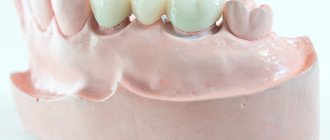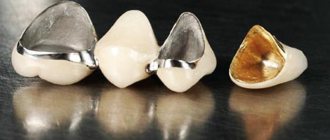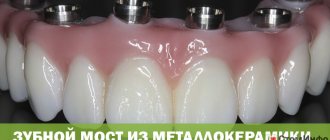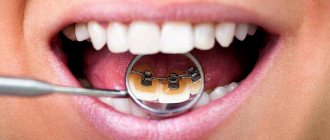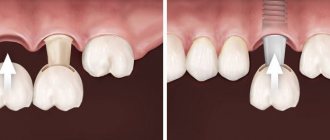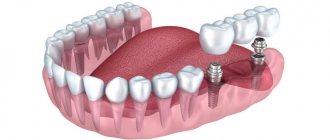From this article you will learn:
- what types of dental bridges are there?
- pitfalls when choosing,
- how much does it cost to put a bridge on teeth – price 2022.
A bridge is a non-removable structure consisting of dental crowns connected into a single unit, which is used to replace missing teeth. Fixation of such a prosthesis can be carried out either on teeth ground for crowns (located on the sides of the dentition defect), or supported by dental implants. As for the length of bridges, they can be from 3 to 14 units long (the number of crowns in the prosthesis).
There are many options for bridges. Bridges supported by teeth ground for crowns can be made of metal-ceramics, metal-free ceramics (for example, zirconium dioxide and Emax glass-ceramics), metal-plastic, or only metal. Bridges supported by implants can only be made of metal ceramics or zirconium dioxide. This article will help you choose a dental bridge, taking into account the location of the missing teeth, as well as your requirements for aesthetics and reliability.
Options for fixing bridges –
Bridges with fixation on teeth ground for crowns can only be used for defects in the dentition of no more than 1-2 teeth in a row. If you are missing 3 or more teeth in a row, a regular dental bridge cannot be installed, because... chewing pressure will lead to overload and loosening of the supporting teeth. In this case, either a bridge supported by implants is indicated, or a less preferable option is the manufacture of a removable denture.
Today, there are many options for making bridges. And this is not only the aesthetically acceptable types of prosthetics listed above - such as metal-ceramics or metal-free ceramics. A dental bridge can also be made - 1) from metal-plastic, 2) entirely from metal, 3) from plastic reinforced with fiberglass or metal mesh, 4) from fiberglass and a composite filling material.
How to put a bridge on teeth -
Installing a bridge on teeth is carried out as follows... The teeth located on the sides of the missing one will act as support for the bridge. If only 1 tooth is missing, crowns are usually taken on one tooth on each side of the missing one. If 2 teeth are missing in a row, then a total of at least 3 teeth are taken under the bridge supports (one on one side of the dentition defect, and two on the other).
How to put a bridge on teeth: diagram and photo
Installing a bridge requires grinding down the supporting teeth for crowns, and here it must be taken into account that for different types of artificial crowns the thickness of the preparation will differ. For metal-ceramics, teeth are ground from the chewing surface by 2.0-2.5 mm, from the lateral surfaces by 1.5 mm (Fig. 4). For crowns made of metal-free ceramics - only 1.5 and 1.0 mm, respectively (Fig. 5). Moreover, the more tooth tissue is preserved under the artificial crown, the longer its service life will be.
Schemes for preparing teeth for crowns –
Moreover, please note that in the gingival zone, the tooth crown is ground in such a way that a so-called “ledge” (i.e., a step, Fig. 6) is formed along the entire perimeter of the tooth stump. The service life of the crown will largely depend on the quality of the ledge formation, because poor/inaccurate fit of the crown to the neck of the tooth in the area of the ledge - leads to the gradual entry of bacteria under the crown and the beginning of decay of the tooth tissue. And this happens very often.
Preparation of supporting teeth for prosthetics –
In many cases, teeth under artificial crowns are subject to depulpation, i.e. the nerve will need to be removed. This is due to the fact that deep in the tooth there is a neurovascular bundle (pulp), and the more tissue is ground off when preparing a tooth for a crown, the higher the risk of nerve injury. Accordingly, because Under metal-ceramics, more tooth tissue is ground off - here it is possible to leave mainly only large molars alive (they have a greater thickness of hard tissue around the nerve).
But for ceramic crowns, almost 2 times less tooth tissue is ground off, and in this case, almost all the teeth can be left alive. Keeping your teeth alive is very important because... after removal of the neurovascular bundle, the tooth stops receiving moisture and nutrition from the inside, which leads to an increase in the fragility of the hard tissues of the tooth and reduces its service life. The cost of removing nerves and filling root canals will depend on the number of root canals in the supporting teeth, and on average will be (for 1 tooth) –
- tooth with 1 root canal – from 2500 rubles,
- tooth with 2 channels – from 3800 rubles,
- tooth with 3 channels – from 5,000 rubles.
Dental bridge: before and after photos
Important: if the adjacent teeth from the missing one do not have fillings and are alive, then prosthetics with a bridge and grinding down the adjacent teeth for crowns is actually a very bad idea. The price of a dental bridge of 3 units made of ceramics or good metal-ceramics (taking into account the cost of preparing teeth for prosthetics) is almost always higher - when compared with the cost of installing 1 economy-class implant.
A dental bridge should be done only if the adjacent teeth from the missing one have large fillings (taking up more than 1/2 of the tooth crown in volume), and also if the nerves have been removed from them. Remember that the service life of the best crowns will be, at best, no more than 10-15 years, and what will happen to the supporting teeth after this time, and whether they can be re-used with prosthetics is still a big question. Your own living teeth (as opposed to artificial crowns) can last you much longer.
Service life
The average service life of plastic bridges is 2-3 years, i.e. During this period, these structures fully retain all their original indicators.
It is possible to extend the operating time up to 5 years if you properly care for them and follow all operating rules . On the contrary, the lack of proper care, ignoring or insufficiently strictly following the recommendations of a specialist, deteriorates the quality of the structure, and accordingly reduces the service life.
In addition to observing the rules of hygiene and wearing, other factors also directly influence the life of the bridge, namely:
- quality and number of supporting teeth holding this structure;
- prosthesis length;
- condition of periodontal tissues;
- uniform distribution of chewing load.
Important! If the denture is the only way to chew food, its service life will naturally be significantly reduced.
Dental bridge: what material is best to choose from?
If we are talking about prosthetics of the front teeth, then according to statistics, most patients are dissatisfied with the bridges made for them.
As we said above, it is very difficult to make artificial crowns similar in color and transparency to neighboring teeth and, of course, good aesthetics today can be achieved mainly only by using metal-free ceramics - 1) Emax glass ceramics, 2) zirconium dioxide. But we also don’t forget about metal-ceramics, although there is one problem with it when prosthetizing the front teeth. Modern metal-ceramics in some cases can look almost as aesthetically pleasing as metal-free ceramics, but for this it is necessary - 1) to use expensive ceramic masses, 2) metal-ceramics must be made with the so-called “shoulder mass”. But this raises the cost of a metal-ceramic bridge to 20,000 rubles (for 1 Unit/crown). And this is practically the cost of 1 unit of pressed ceramics “Emax”.
Below we will talk in detail about which bridge is optimal for the front teeth (in terms of materials and budget). But with prosthetics with bridges in the area of chewing teeth, the situation is much easier, because here functionality is more important than aesthetics. And in this case, we have a number of optimal solutions, including more affordable ones, although the gold standard for chewing teeth is now expensive bridges made of monolithic zirconium dioxide.
Below we compare the following types of bridges -
- bridges made of metal-free ceramics (zirconium dioxide, E.max),
- metal-ceramic dental bridges,
- solid bridge made of cobalt-chrome alloy,
- adhesive bridge prosthesis.
General overview
A plastic bridge is a non-removable orthopedic structure. Structurally, such a prosthesis is represented by the following elements:
- Two crowns that are placed on the supporting teeth (healthy and stable elements that can withstand constant chewing load, or implants, are always used as supports).
- Intermediate part , consisting of artificial dental units (1-4 pieces) and filling the gap in the dentition.
The material itself is endowed with the following characteristics:
- easily destroyed;
- deformed;
- has low cost;
- unesthetic;
- not strong enough;
- absorbs foreign odors well;
- changes color when exposed to food coloring;
- favorable for the proliferation of pathogenic microflora due to its porosity.
Based on the listed indicators, bridges are recommended for prosthetics of small defects in the lateral and frontal sections that are the result of pathological changes in hard tissues, trauma, or anomalies in position and shape.
But due to the emergence of more technologically advanced materials, plastic prostheses began to be used for temporary prosthetics . For the same reason, it is not recommended to reconstruct missing molars.
Important! Only in the absence of one of the molars, with bilateral support provided, is the bridge allowed to be installed, but it gives only a relatively reliable effect.
Can an allergy to plastic crowns occur and how to prevent its occurrence.
Come here if you are interested in the price of dental prosthetics in Heihe.
At this address https://zubovv.ru/protezirovanie/nesemnyie-p/vazhnoe-o-sostavnyih-mostovidnyih.html we will consider the components of a bridge prosthesis.
Zirconium dioxide dental bridges –
Zirconium dioxide ceramic bridges are manufactured using CAD/CAM technology, which involves milling bridges from pressed zirconium dioxide blocks on a computer-controlled machine. Sintered zirconium dioxide has a strength comparable to metal (more than 900 MPa). Thanks to this, zirconium dental bridges can be made of any length - even horseshoe-shaped bridges with a length of 12-14 teeth (which cannot be made from any other types of metal-free ceramics).
We have already said above that a zirconium bridge is the gold standard for prosthetics of the chewing group of teeth. But there are questions about the aesthetics of zirconium dioxide bridges, and when prosthetizing the front teeth, you may encounter a big problem (the bridge will stand out against the background of the patient’s own teeth). The fact is that there are 2 types of bridges and crowns made of zirconium dioxide, and they differ from each other not only in aesthetics, but also in the risk of ceramic chips.
1) “Traditional” zirconia bridges –
For such bridges, only the internal frame will be made of zirconium dioxide, which is lined with ceramic mass, or rather porcelain, on the outside (Fig. 14). And this is due to the fact that most dental laboratories use cheap versions of zirconium dioxide blocks. This zirconium dioxide has a bright white color, plus it is completely opaque, and as a result, such a material does not allow achieving a certain degree of translucency, which is characteristic of natural tooth enamel.
Crowns and bridges made from such material will have an unnatural milky white color, plus there will be no translucency characteristic of natural teeth. Therefore, in order to improve aesthetics, only the internal frame is milled from such zirconium dioxide, which gives strength to the structure, and then the dental technician, by applying layers of porcelain, gives the crowns of the bridge the final shape and color. But even despite this, the aesthetics of such crowns and bridges will be far from perfect.
Plus, this manufacturing method has another disadvantage. We have already said above that zirconium dioxide has the strength of a metal (from 900 MPa), however, the layer of porcelain mass on the surface of the zirconium frame has a strength of only 80-120 MPa. This leads to chips of the ceramic mass (according to statistics, within 6 years they occur in approximately 10% of patients). The chips are repairable, but the reliability of such repairs leaves much to be desired.
Conclusions : we do not recommend using zirconium dioxide bridges (made with a surface layer of porcelain) for prosthetics of chewing teeth, because in this case there will be a high risk of chipping. When replacing front teeth with prosthetics, this option is not very successful, because the crowns of the bridge will still have an unnatural milky tint, standing out against the background of your own teeth (Fig. 15-16). Plus, there is still a risk of chipping the porcelain lining.
The aesthetics of such structures are
Such milky-white crowns and bridges made of zirconium dioxide will look acceptable only in one case - if you are going to simultaneously prosthetize all the teeth that fall into the smile line on both the upper and lower jaws (i.e. at least the fifth teeth inclusive ). Otherwise, such a bridge will be very noticeable against the background of your own teeth.
2) Zirconium bridges using “Multi-layer” technology –
But the problem of poor aesthetics and chipping was solved by the advent of the next generation of zirconium dioxide blocks/discs. Currently, a number of manufacturers produce zirconium dioxide with “Multi-layer” technology. Discs made from such zirconium dioxide are “pre-colored”, i.e. they have a color gradient that is characteristic of the enamel of real teeth. The second difference: due to the stabilization of zirconium dioxide by yttrium, such blocks will have varying degrees of “transparency”, i.e. translucency.
As a result, crowns and bridges made from such material will have a gradient of color and transparency, which will vary from the neck of the tooth to the incisal edge (the cusps of the chewing teeth). Those. The closer to the incisal edge, the lighter and more transparent the zirconium dioxide becomes. But multi-layer technology can provide more than just good aesthetics! In this case, there is no need to use surface layers of porcelain, and therefore crowns and bridges will be made of monolithic zirconia.
Clinical case No. 1 – below you can see the aesthetics of newly made single crowns and bridges made of zirconium dioxide, made using the “Multi-layer” technology (they are not yet fixed in the oral cavity, but are on a plaster model of the patient’s teeth). The bridge prosthesis in the projection of 14-15-16 teeth is made with artificial pink gum, and the remaining units are made in the form of single zirconium crowns. With these photos we want to show a smooth transition of color and transparency.
Therefore, if you want to get decent aesthetics, then when you go to a dental clinic, you need to find out whether they use “Multi-layer” zirconium dioxide. High-quality discs using this technology: these are 2 variants of Katana® discs - UTML or STML (Japan), as well as Prettau® Anterior (Germany). The cost of one such disk starts from 16,500 rubles. For example, a disc made of ordinary white opaque zirconium dioxide costs only 4,500 rubles, and therefore many clinics, in an attempt to save on costs, work with cheap, outdated materials.
Conclusions: if you need a bridge prosthesis on implants, or a bridge prosthesis in the area of chewing teeth, then a bridge made of monolithic zirconium dioxide using the Multi-layer technology is not the cheapest, but the best option. When it comes to front teeth prosthetics, if you want to get the best aesthetics possible, there are limitations. For example, if you are planning to make a bridge or crowns on all front teeth (falling into the smile line), then Multi-layer zirconium dioxide will allow you to get the ideal aesthetic result.
However, if you need a bridge for only 3-4 teeth, then even with the help of the Multi-Layer technology, a dental technician is unlikely to be able to make such a structure absolutely indistinguishable from neighboring natural teeth. In this case, to achieve ideal aesthetics, it is worth choosing a bridge not from zirconium dioxide, but from pressed Emax ceramics. This is due to the fact that when working with Emax, the dental technician will have significantly more color options in his arsenal (than when working with any option of zirconium dioxide), which will make the bridge as similar as possible to the neighboring teeth.
Cost – for zirconium bridges, the price for 2022 in Moscow will be on average from 30,000 to 40,000 rubles (for 1 Unit/crown). Thus, the cost of a 3-unit bridge will be at least 90,000 rubles. However, in a number of clinics you may well be offered a price of less than 30,000 per unit, but in this case the bridge will clearly not be “multi-layer” or monolithic.
Nuances of fixation
As soon as the finished bridge arrives at the clinic, the doctor begins installing it. Fixation is first performed with temporary cement. This measure allows you to evaluate the comfort of the bridge while wearing it. If any problems are detected, the doctor takes measures to eliminate them.
If the patient does not make any complaints, and no side effects were identified during wearing, the bridge is fixed on a permanent basis.
The dentist performs all actions in the following sequence:
- The junction of the bridge with the supporting elements is treated with a means that allows it to be easily removed.
- The inside of the prosthesis is thoroughly cleaned, washed and dried.
- Support units are treated with an antiseptic.
- A permanent cement paste is applied to them.
- A bridge is being installed.
- Remains of cement are removed.
Upon completion of installation, the patient is given recommendations regarding the care of the prosthesis and oral cavity, and the rules for using the product are explained.
E.max ceramic dental bridge –
If you are planning prosthetics on your front teeth, then a dental bridge made from IPS E.max ceramics is the best option in terms of aesthetics (even compared to bridges made from Multi-layer zirconium dioxide).
The “Emax” material refers to glass ceramics, because this material consists of 70% lithium disilicate crystals. Due to the fact that the E.max glass matrix is as similar in structure and transparency as possible to natural tooth enamel, crowns, veneers and bridges made from this material can be made completely invisible against the background of neighboring teeth. Clinical case No. 1 – before and after photos
Clinical case No. 2 – before and after photos
E.max glass ceramics is practically the only material that allows achieving good aesthetics in patients with a high level of transparency of tooth enamel (if the transparency coefficient is low, then good aesthetics can be achieved with zirconium dioxide). E.max crowns require less grinding of the supporting teeth, which increases their service life. And besides, the use of this material practically eliminates the occurrence of ceramic chips.
Important points - E.max ceramics are available in several versions, but for the manufacture of bridges it is best to use “IPS E.max PRESS”. Bridges are made from this material by pressing under conditions of very high temperature and pressure, making the finished structure very strong (about 400 MPa). However, there are several limitations for E.max bridges...
Firstly, you can make bridges from E.max with a length of no more than 3 units, i.e. They can only restore a single missing tooth. Secondly, their safety margin is sufficient to restore mainly only the anterior group of teeth (the distant abutment tooth should be no further than the 5th tooth inclusive). Therefore, if you need to restore the chewing group of teeth, then a priori the choice falls on bridges made of zirconium dioxide or metal ceramics.
Conclusion: The E.max glass-ceramic bridge is the best option if you require a 3-unit bridge in the anterior area and if you have the highest esthetic requirements. Considering that 1 crown made of E.max PRESS material will cost in Moscow in 2022 - from 26,000 rubles, then the cost of a bridge of 3 units will already be about 72,000 rubles. In the regions, the price for 1 unit may be slightly less (from 20,000 rubles). And don’t be confused by the fact that E.max is cheaper than bridges made of zirconium dioxide - it’s just that very expensive equipment is used in the manufacture of the latter, which affects the cost.
Plastic dentures: a budget-friendly temporary solution to the problem of missing teeth
One of the most affordable methods of prosthetics is the use of plastic crowns and dentures. Quite often, the creation of a permanent orthopedic structure takes time, so inexpensive products made of acrylic plastics are installed until it is ready. We’ll talk about what a plastic crown and prosthesis look like, as well as the specifics of their use later in our article.
What is a plastic tooth crown? In appearance, it is, in general, not inferior to ceramic analogues. But let's figure out how plastic crowns differ from metal-ceramics and ceramics? First of all, strength, because plastic is a rather fragile material that is subject to deformation. Products made of metal with ceramic lining and even solid ceramics cope much better with constant pressure.
According to recognized experts in the field of prosthetics, the maximum operational period of such products does not exceed 3 years. How long a prosthesis lasts directly depends on the properties of the material. Plastic is subject to abrasion, so the walls of the crown must be much thicker than in permanent products. This means that in the process of treating a tooth, a specialist has to remove an impressive layer of tissue, that is, to prepare the tooth quite heavily.
Metal-ceramic bridges –
Metal ceramics have a cast metal frame inside (Fig. 21), lined with porcelain on the outside. Unlike ceramics, metal is completely opaque, and therefore only opaque porcelain can be used to disguise it. The latter leads to the fact that metal-ceramic bridges and crowns will lack the translucency of natural tooth enamel, and their aesthetics will not be as good as that of metal-free ceramics.
The problem with aesthetics when using metal-ceramic prosthetics is somewhat reduced if you are going to prosthetize all the teeth that fall into the smile line at once (for example, at least from canine to canine). In this case, when talking, your interlocutors will see only the same “teeth”. But the problem with aesthetics is especially noticeable if a metal-ceramic bridge is installed on only 3-4 teeth, and in this case the crowns will stand out noticeably against the background of neighboring natural teeth.
Clinical case of metal-ceramic prosthetics –
The cost of 1 unit of metal ceramics varies on average from 12,000 to 18,000 rubles. Cheap metal ceramics costing from 8,000 to 10,000 rubles per unit also exist, but in this case the simplest ceramic mass (most likely of Belarusian or Russian production) will definitely be used, which simply lacks aesthetics. For 12,000 rubles per unit, you can already get bridges or crowns from Duceram ceramic mass (Germany), which at the very least provides a satisfactory level of aesthetics.
If more expensive ceramic masses are used, for example, it could be “Ivoclar” (Liechtenstein), then the cost of just 1 crown will increase to 15,000 rubles. The use of even higher quality ceramics “Noritake” (Japan) or “Vita” (Germany) will increase the cost to 18,000 rubles per unit, and therefore, if we are talking about a bridge of 3 units, then you need to multiply this amount by three. The amount of 18,000 rubles per 1 unit for good metal ceramics is not the maximum, and here’s why...
If we are talking about dental bridge prosthetics for the front teeth, then expensive ceramic mass alone is no longer enough to achieve good aesthetics. The fact is that with standard metal-ceramics, the lower edge of the metal frame (which is located just below the gum level) is not insulated with ceramics, and therefore it will always be in contact with the gum. Firstly, this leads to the gradual development of cyanosis of the gums, and secondly, to a gradual lowering of the gum level and exposure of the dark metal edge of the metal-ceramic crowns of the bridge (Fig. 24-25).
Therefore, if you are going to make a bridge on chewing teeth, all this may not be important, but in the area of the front teeth these problems will be critical. Only a type of metal-ceramic with the so-called “shoulder mass” can avoid the appearance of cyanosis, but the cost of 1 Unit of a bridge immediately increases by another 5,000 rubles (for the high complexity of manufacturing). So it turns out that for high-quality prosthetics with a bridge prosthesis for the front teeth, a bridge made of Emax metal-free ceramics can cost less than a good metal-ceramic one.
What does “metal-ceramic with shoulder mass” mean – as we said above – using a more expensive ceramic mass will not save you from the appearance of cyanosis and gum recession. For the latter, there are metal-ceramic bridges/crowns with the so-called “shoulder mass”, in which the lower edge of the metal frame is additionally insulated with ceramic mass. Ceramic insulation can be done either along the entire perimeter of the edge of the metal frame, or only on the front side of the crown (Fig. 27).
Conventional metal-ceramics and “with shoulder mass” –
As we said above, the cost of 1 unit of metal ceramics with shoulder mass will be an additional 5,000 rubles (for 1 unit). For a 3-unit bridge with shoulder mass, 2 crowns must be made, i.e. only those that will be on the supporting teeth. Accordingly, if we want a metal-ceramic bridge made of high-quality ceramics, then it will cost at least 45,000 rubles (and an additional + 10,000 rubles to this cost will also be used to create shoulder mass for crowns on abutment teeth). Total 55,000 rubles.
Important: it is worth considering that when calculating the cost of a dental bridge made of metal-ceramics, there are some other cost items. For example, the cost of temporary crowns made of plastic will be another 2,000 rubles per unit. Secondly, the cost of preparing supporting teeth for prosthetics, which can amount to another 2,500 to 8,000 rubles per tooth (depending on the number of root canals). As we see, to restore 1 missing front tooth it will be cheaper to install an economy-class implant, which even with a ceramic crown will cost you about 50,000 rubles.
Adjustment time
The period of adaptation to bridge prostheses directly depends on its type. Thus, the non-removable structure will no longer remind you of itself three days after its installation. Adapting to removable products is much more difficult. This period can last up to half a month.
Why can our articles be trusted?
We make health information clear, accessible and relevant.
- All articles are checked by practicing doctors.
- We take scientific literature and the latest research as a basis.
- We publish detailed articles that answer all questions.
No specialist can say the exact timing of addiction. This process is individual and depends on a number of factors:
- dimensions ;
- characteristic features of the transmission of chewing pressure;
- the chosen method and degree of fastening of the product;
- reaction to a foreign body in the oral cavity.
Dentures with suction cups
Modern dentistry has come a long way in recent decades.
After installation of the prosthesis, patients are advised to take food more seriously for some time and follow these rules:
- for two weeks, eat exclusively pureed, liquid food and cereals;
- Avoid putting stress on the dentures. Eliminate crackers, dried fruits and other hard foods from the diet;
- gradually, in the process of habituation, include more solid foods in the diet.
In some cases, when wearing dentures regularly, scratches and inflammation may form on the mucous membrane of the gums. In this case, you should make sure that the structure is put on correctly. The easiest way to do this is to look at it in front of a mirror.
In exceptional cases, patients may experience a gag reflex in the process of getting used to a foreign body in the oral cavity. To get rid of this phenomenon, experts recommend performing the following manipulations:
- perform deep breathing exercises through the nose;
- rinse your mouth with a weak salt solution;
- suck on lollipops as often as possible .
Repair of dentures
A broken prosthesis is not a rare situation and occurs in 10 percent of orthopedic treatment cases.
If there is a violation of diction, then the patient must follow these recommendations:
- read aloud, but very slowly and quietly;
- only after quiet speech has been mastered, increase the tone;
- pay special attention to the pronunciation of consonants ;
- read as often as possible (up to ten times a day), but only for five, maximum ten minutes.
Speech in most cases is restored within 2 weeks. Depending on individual characteristics, this period may be longer.
There are a number of additional recommendations, following which the process of getting used to the prosthesis can be significantly accelerated:
- regularly clean the denture and massage the gums, followed by rinsing the mouth;
- resort to the use of fixing agents in cases where the structure is not very stable;
- strictly follow all medical recommendations.
The adaptation period after prosthetics is short. If the patient takes this as seriously as possible and follows all the rules, then within a few days after installation the prosthesis will feel not like a foreign body, but like natural teeth.
Solid-cast bridges –
A solid-cast bridge is the most cost-effective type of prosthetics.
Accordingly, its main disadvantage will be unsatisfactory aesthetics (polished metal). Therefore, solid bridges are used mainly only in the area of chewing teeth, i.e. outside the smile line. The cost of 1 unit of such a bridge will be from 5,000 to 6,000 rubles, and thus a bridge of 3 units will cost you approximately 15,000 rubles. Solid dental bridge: photo
The advantage of solid-cast bridges is that the supporting teeth are ground down for crowns to a slightly lesser extent than for metal-ceramics. Of course, this guarantees greater preservation of the hard tooth tissues under the crown, as well as a longer service life. In some cases, at the request of the patient, plastic overlays can be made on the front side of the crowns on one or all of the crowns of a solid-cast bridge. This will certainly improve the aesthetics, but it is not very reliable, and in addition, the plastic will gradually lose its aesthetic qualities.
Bridge installation: contraindications and indications
Direct indications for the installation of bridges are the absence of one chewing tooth or from one to four front teeth with supporting teeth on either side of them that can withstand the increased load. Dental prosthetics using a bridge has a number of relative and absolute contraindications. These include:
- absence of no more than 4 incisors, 2 premolars, 1 molar in a row;
- bruxism (involuntary grinding of teeth, the harm from which can be mitigated by wearing special mouthguards);
- pathology of the bite (in this case, you will have to undergo orthodontic treatment before prosthetics);
- periodontitis and severe periodontal disease;
- pathological abrasion of hard dental tissues;
- diseases of the bone tissue of the jaw (for example, osteoporosis, osteomyelitis);
- acute inflammatory diseases of the oral cavity;
- poor oral hygiene.
This also includes general contraindications to surgical intervention as such: such as, for example, problems with blood clotting, allergies to painkillers, chronic diseases in the acute stage, taking anticoagulant medications, mental illness, and more.
Combined bridges –
Because Both metal-ceramic and solid-cast bridges are made on a cast metal frame - different types of crowns can be combined in one bridge. For example, you need to make a bridge of 3 units supported by teeth 5-7 (Fig. 29). In this case, the nearest 1-2 crowns that fall into the smile line can be made with ceramic veneer (i.e., metal-ceramic), and the distant crowns that do not fall into the smile line can be made solid.
This will somewhat reduce the cost of a dental bridge, plus for solid crowns, the teeth are ground to a slightly lesser extent and, accordingly, in this case, more tooth tissue will be preserved under the crown. If you are not bothered by the fact that metal may be visible when you open your mouth wide, this is a completely worthy prosthetic option.
Stages of prosthetics
The installation of the bridge takes place in several stages:
- Sanitation of the oral cavity, treatment of caries and gum inflammation;
- Inspection and selection of prosthetic options;
- Grinding of teeth if necessary, or implantation of implants;
- Taking impressions;
- Installation of a temporary plastic prosthesis;
- Fixation of the finished prosthesis with dental cement.
Now let's look at the stages of making a bridge:
- The taken impressions are sent to the laboratory, where they are used to make a plaster model of the jaw;
- Using the model, the technician makes a frame that is fitted to the patient’s teeth;
- The frame is adjusted and wax casts are taken for the structure itself;
- The material is selected, and the technician casts the frame from it, lining it with ceramics if necessary and baking everything in the oven.
Adhesive bridge prosthesis –
An adhesive bridge is a temporary structure with a service life of up to 2 years. It is made of fiberglass tape (it stretches from one supporting tooth to another, serving as a stiffening rib), and conventional composite filling material (Fig. 31-34). Such designs are characterized by low reliability, but at the same time they can be quite aesthetic (although their aesthetics will not last too long).
Stages of manufacturing an adhesive prosthesis –
Adhesive bridges: reviews
- The advantages of adhesive dentures include: firstly, rapid production directly in the patient’s mouth in an average of 1.5 hours, and secondly, lower cost (compared to other types of bridges). The cost of an adhesive bridge will be from 13,000 rubles.
Disadvantages of adhesive prostheses –
- can be made only with a single missing tooth,
- Canines and molars (3,6,7 teeth) cannot be restored,
- low reliability (service life up to 2 years),
- To fix the fiberglass beam, it is necessary to create platforms (ledges) on adjacent teeth, thus compromising the integrity of the teeth.
Key advantages and disadvantages
Plastic orthopedic systems have their advantages, including ease and speed of production, as well as affordable cost. In addition, in the first months after fixation, such products look very aesthetically pleasing, since the material allows you to choose a shade that ideally matches the natural color of the enamel. Plastic dentures can be repaired and do not need to be removed for this, which is also quite a significant advantage.
“I have white metal-plastic crowns on my two front teeth. I can honestly say that they look quite convincing. Over time, I stopped noticing any differences from my own teeth. In my case, I didn’t have to do much tooth preparation. And for the money it turned out to be very reasonable. I hope to hold out for a long time, however, the doctor did not give me any guarantees. In any case, I don’t see any point in overpaying yet!”
Ekaterina, 32 years old, fragment of a message on a thematic forum
Despite the presence of undeniable advantages, crowns and dentures made of plastic are not durable, and are also characterized by a whole list of other disadvantages:
- color change over time - under the influence of food coloring, nicotine,
- porous structure, which becomes an ideal environment for the accumulation of bacteria,
- risk of developing allergies (but mainly when adding metal),
- the possibility of damage to the mucous membrane by the sharp edges of the product,
- the need for tooth preparation,
- the formation of a gap between the cladding and the frame in the case of metal-plastic structures.
In addition, there are many contraindications - such products are not suitable if the patient is allergic to plastic or metal, as well as a tendency to bruxism - involuntary clenching of the jaws during sleep. A professional, experienced doctor will help you choose the optimal method of prosthetics after diagnosis.
Important! Do not forget that prolonged wearing of a removable denture inevitably leads to bone tissue atrophy. The optimal solution to this problem would be dental implantation, which allows you to restore the full functioning of the dental system.
Reviews
Due to the fact that materials such as zirconium dioxide and ceramics have appeared in the dentist’s arsenal, plastic products are losing their relevance.
In addition, most patients note the advantages of metal-ceramic and metal-plastic structures.
You can leave your opinions and comments at this point in this article.
If you find an error, please select a piece of text and press Ctrl+Enter.
Tags: dental bridges, fixed prosthetics
Did you like the article? stay tuned
Previous article
Is it possible to put a crown on a living tooth - all the pros and cons
Next article
Which coated metal crown is best to choose?
Description of design
A plastic bridge prosthesis is used for dental prosthetics when there are no consecutive elements.
Most often, this type of bridge connection is used as a temporary product. This is due to the fact that plastic is a fragile material, the warranty period in this case does not exceed 2 years.
The design of the prosthesis includes the following elements:
- two crowns that are placed on the supporting units;
- the intermediate part is filled with artificial elements (no more than 4 pieces);
- To withstand the load, 2 healthy abutment teeth are selected.
It must be borne in mind that these structures are not highly aesthetic, which is why practitioners use them to temporarily restore chewing functions.
Features of caring for new teeth
How to care for and store removable and fixed dentures? Answering this question, you should pay attention to the fact that removable structures must be removed at least twice a day for hygiene procedures. How to clean the denture? A regular toothbrush and toothpaste will help. Experts also advise eliminating too hard and viscous foods from your diet.
Dental hygiene
Many patients are interested in the question: why does a plastic crown darken and how to whiten it. It's all about the properties of the material, which is susceptible to coloring with food pigments. Unfortunately, it is impossible to bleach plastic. It is better to give up coffee, tea, berries and other coloring foods, as well as smoking in advance. During cleaning, the use of pharmaceutical solutions is allowed.
